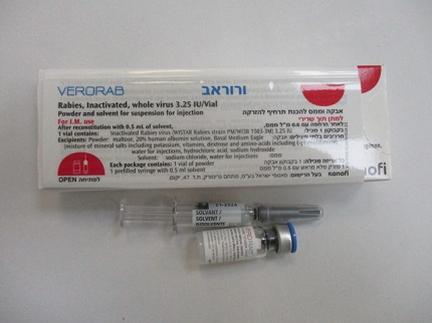Quest for the right Drug

ורוראב VERORAB (RABIES, INACTIVATED, WHOLE VIRUS)
תרופה במרשם
תרופה בסל
נרקוטיקה
ציטוטוקסיקה
צורת מתן:
תוך-שרירי : I.M
צורת מינון:
אבקה וממס להכנת תרחיף להזרקה : POWDER AND SOLVENT FOR SUSPENSION FOR INJECTION
עלון לרופא
מינוניםPosology התוויות
Indications תופעות לוואי
Adverse reactions התוויות נגד
Contraindications אינטראקציות
Interactions מינון יתר
Overdose הריון/הנקה
Pregnancy & Lactation אוכלוסיות מיוחדות
Special populations תכונות פרמקולוגיות
Pharmacological properties מידע רוקחי
Pharmaceutical particulars אזהרת שימוש
Special Warning עלון לרופא
Physicians Leaflet
Posology : מינונים
4.2 Posology and Method of Administration Posology: VERORAB can be administered to adults and children, using the same posology. The vaccination schedule should be adapted in accordance with the circumstances of vaccination and the subject's rabies immune status. 4.2.1. Pre-Exposure Vaccination Three doses of VERORAB (0.5 ml) should be administered on D0, D7 and D28 or D21. Booster Injection after Pre-Exposure Vaccination A VERORAB booster injection (0.5 ml) should be administered one year after primary vaccination, followed by a booster injection every 5 years (see Table 3). Table 3: Recommendations for Primary Vaccination and Booster Injections Primary vaccination 3 Injections D0, D7 and D28* 1st booster injection 1 year later Subsequent booster injections Every five years * *The D28 injection can be administered on D21. VERORAB can be administered as a booster injection after primary vaccination with a cell culture rabies vaccine (a rabies vaccine prepared on VERO cells or prepared on human diploid cells (HDCV)). 4.2.2. Post-Exposure Vaccination First Aid: Local Treatment of the Wound All bites and scratches should be immediately flushed out and washed with soap or detergent. Doing so can enable efficient elimination of the rabies virus at the infection site. A 70 % alcohol solution, a tincture (or solution) of iodine, or a 0.1 % quaternary ammonia solution can then be applied (provided that there are no remaining traces of soap, because these two products neutralize each other). Depending on the severity of the injuries, rabies immunoglobulins (RIGs) may have to be administered in association with the vaccine. In this case, refer to the instructions for use in the RIG package leaflet. If necessary, treatment can be supplemented by the administration of a tetanus prophylaxis treatment and/or antibiotherapy. Fully Immunised Subjects Two booster doses of VERORAB (0.5 ml) should be administered on D0 and D3. Administration of rabies immunoglobulins (RIGs) is not necessary and should not be performed in this case, since booster injection is always followed by an anamnestic response. Previously immunised subjects should be able to document the following: - Full pre- or post-exposure rabies vaccination, by a cell culture vaccine or - A documented rabies antibody titre ≥ 0.5 IU/ml In case of doubt, if the booster injection was administered more than 5 years ago, or in the case of incomplete vaccination, the patient should not be considered to be completely immunised, and complete post-exposure treatment should be initiated. Table 4: Recommendations for Post-Exposure Rabies Vaccination Depending on Previous Vaccinations Vaccination within the last 5 years (with a cell 2 injections: D0 and D3 culture rabies vaccine) Vaccination more than 5 years ago or 5 injections: on D0, D3, D7, D14 and D28, incomplete vaccination with RIG administration if necessary Non-Immunised Subjects Five doses of VERORAB (0.5 ml) should be administered on D0, D3, D7, D14 and D28. Rabies immunoglobulins (RIGs) should be administered concomitantly with the first injection in the case of a severe injury (category III, according to the WHO rabies risk classification). It can be administered later, but not after the 7th day of vaccination. Equine and human immunoglobulins can be used with VERORAB. The internationally recognized RIG posology is as follows: Human rabies immunoglobulins: 20 IU/kg of body weight Equine rabies immunoglobulins: 40 IU/kg of body weight Because RIGs may partially inhibit active antibody production, no more than the recommended dose should be administered. The vaccine should be injected contralaterally to the RIG administration sites. In enzootic rabies areas, the administration of two vaccine injections on D0 may be justified, e.g. in the case of lesions that are extremely severe or located near the nervous system, or when the subject is immunodeficient or did not come in for a medical consultation immediately after exposure. Method of administration Precautions to be taken before handling or administering the medicinal product. The vaccine is administered via the intramuscular route, in the anterolateral region of the thigh muscle in infants and young children and in the deltoid muscle in older children and adults. Do not inject in the buttocks region. Do not inject via the intravascular route. For instructions on reconstitution of the medicinal product before administration, see section 6.6.

שימוש לפי פנקס קופ''ח כללית 1994
לא צוין
תאריך הכללה מקורי בסל
לא צוין
הגבלות
לא צוין
מידע נוסף
